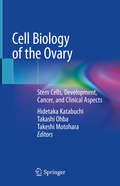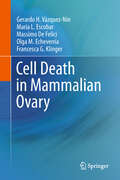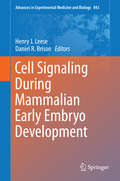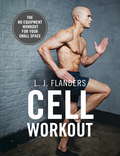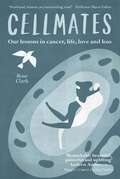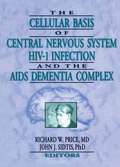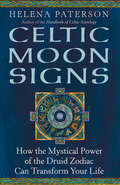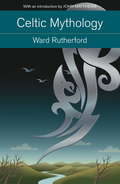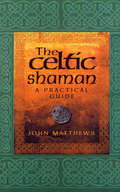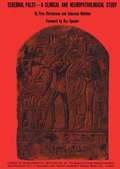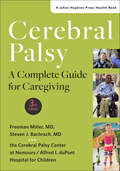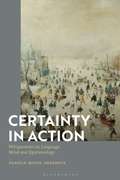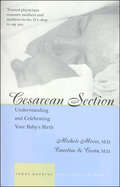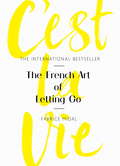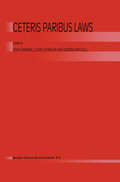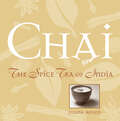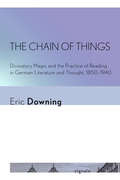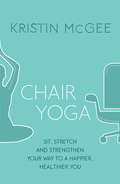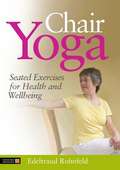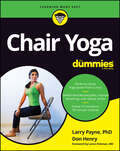- Table View
- List View
Cell Biology of the Ovary: Stem Cells, Development, Cancer, and Clinical Aspects
by Hidetaka Katabuchi Takashi Ohba Takeshi MotoharaThis unique compilation focuses on a very curious organ, the ovary. There are still many unknown facts about the origins of ovarian tissue and ovarian cancer, and each chapter describes in detail the latest insights into the ovary from basic to clinical aspects. Expert authors reveal the most recent findings on ovariogenesis and ovarian carcinogenesis by shedding light on stem cell biology for the ovarian surface epithelial cells or primordial germ cells. Readers will greatly increase their understanding of the relevance of the cells that constitute the ovary, which is of vast significance in comprehending the occurrence mechanism of ovarian tissue and ovarian cancer. In this way the book covers a wide range of fields concerned with the ovary. This work benefits not only gynecologists and obstetricians, but also basic researchers in the field of stem cell biology and all clinicians who are involved in the management of fertility preservation or ovarian cancer.
Cell Death in Mammalian Ovary
by Gerardo H. Vázquez-Nin María Luisa Escobar M. De Felici Olga Margarita Echeverría Francesca Gioia KlingerThe ovary is a suitable organ for studying the processes of cell death. Cell death was first described in the rabbit ovary (Graaffian follicles), the phenomenon being called ‘chromatolysis’. To date, it is recognized that various forms of cell death (programmed cell death, apoptosis and autophagy) are essential components of ovarian development and function. Programmed cell death is responsable for the ovarian endowment of primordial follicles around birth; in the prepuberal and adult period, apoptosis is a basic mechanism by which oocytes are eliminated by cancer therapies and environmental toxicants; in the ovarian cycle, follicular atresia and luteal regression involve follicular cell apoptosis. Finally, abnormalities in cell death processes may lead to ovarian disease such as cancer and chemoresistance. In this book, after an introductory description of various forms of cell death and of the ovary development and function in mammals, the processes of cell death in ovarian somatic cells and oocytes are described at cytological, physiological and molecular levels and analyzed in the embryonic, prepuberal and adult ovary. A complex array of molecular pathways triggered by extrinsic and intrinsic signals able tor induce or suppress cell death in the same cell, according to cell type and ovary developmental stage, emerges. Physiological interactions with the axis hypothalamus-hypophysis as well as ovarian internal functional signal are also critically reviewed to explain the abortive development of follicles before the beginning of the ovarian cycle. The book conveys information useful to the updating of biologists and physicians who are interested to the ovary biology and functions. Hopefully it should provide also clues for stimulating novel experiments in the study of cell death in the mammalian ovary still at an early stage.
Cell Signaling During Mammalian Early Embryo Development (Advances in Experimental Medicine and Biology #843)
by Henry J. Leese Daniel R. BrisonThe book considers signaling events from the zygote embryo through to the blastocyst with relevant data from embryonic stem (ES) cells, including dialogue with the extracellular environment and with the maternal tract during the implantation process. Application of the knowledge described to improve the success of human and animal assisted conception is considered where appropriate, but the focus is largely on fundamental rather than applied cell/molecular biology, as this is the area that has historically been neglected. While the general features of metabolism during preimplantation development are well established, especially in terms of nutrient requirements, uptake and fate, remarkably little is known about early embryo signaling events, intracellular or intercellular, between individual embryos in vitro or with the female reproductive tract in vivo. This contrasts with the wealth of information on cell signaling in somatic cells and tissues, as a glance at any textbook of biochemistry illustrates. This lack of information is such that our understanding of the molecular cell biology of early embryos -- a prerequisite to defining the mechanisms which regulate development at this critical stage of the life cycle -- is seriously incomplete. This volume is the first to address this issue by describing the current state of knowledge on cell signaling during mammalian early embryo development and highlighting priority areas for research.
Cell Workout: At home, no equipment, bodyweight exercises and workout plans for your small space
by L J Flanders*** THE NO-EQUIPMENT WORKOUT PERFECT FOR YOUR SMALL SPACE ***CELL WORKOUT is a bodyweight training guide devised from a prison cell but accessible to anyone who wants to get fit in a small space using no specialist equipment.Using your own body weight - the oldest exercise equipment out there - CELL WORKOUT guides you through understanding how to make bodyweight training work for you, helping you to achieve any personal training goal or maintain a healthy physical condition.With workouts for those of varying ability and fitness, the step-by-step exercise instructions and accompanying photographs for LJ's 10 Week Cell Workout are easy to follow and tailor to you, improving all aspects of your physical fitness.This is CELL WORKOUT; get the body you want - inside and out.
Cellmates: Our lessons in cancer, life, love and loss
by Rose T Clark"Remarkably beautiful, powerful and uplifting" (Andrew Anderson, Maggie's Centre). 'I'm Rose. John and I shared nearly eight years of our lives together. For the last three years cancer anchored us together. This is our story, of how two ordinary people live with the diagnosis, the check-ups, the disappointments, the relief, the questions, the answers, the operations, the recovery, the emergencies, the denial, the acceptance, the anger, the pain, the loss, the love, the fear, the frustration and the happiness.' Shortly before he died, John made Rose promise to share their story - to tell what they had learned, practically and emotionally, and convey the hope they found even in the darkest of times. He had discovered her hidden stash of letters and diary entries, which she'd neither censored nor intended others to read. The result is an astonishing, searingly honest, real-time account that reveals our profound capacity for love and how the human spirit can endure the most harrowing of tests to emerge dauntless, flying free. (Caution: contains graphic descriptions of suffering that some may find distressing.)
The Cellular Basis of Central Nervous System HIV-1 Infection and the AIDS Dementia Complex
by Richard W Price John J SidtisIn this exciting symposium, the editor brings to print important new information on AIDS and how HIV affects the brain. Each chapter focuses on one or more of the cell types that reside in or traffic through the central nervous system (CNS). Each of these cells is important to considerations of the pathogenesis of the CNS. Neurologists, AIDS physicians, and other professionals caring for AIDS patients will find that this “cell-based” view provides a unique perspective and that it will guide and stimulate future investigation of this clinically important and pathogenetically intriguing disorder. The editor also introduces some general considerations for therapeutic intervention of AIDS dementia complex (ADC).The contributors to The Cellular Basis of Central Nervous System HIV-1 Infection and the AIDS Dementia Complex deal with the cells and mechanisms involved in HIV-1 brain infection and the resultant ADC. Each author was asked to review the involvement of their assigned cells in CNS HIV-1 infection and how these cells might be involved in the pathology and process of brain injury associated with ADC. Readers will be enlightened on the functional roles of various cells and how these cells and mechanisms might fit into the broader picture of ADC pathogenesis.
The Cellular Basis of Central Nervous System HIV-1 Infection and the AIDS Dementia Complex
by Richard W Price John J SidtisIn this exciting symposium, the editor brings to print important new information on AIDS and how HIV affects the brain. Each chapter focuses on one or more of the cell types that reside in or traffic through the central nervous system (CNS). Each of these cells is important to considerations of the pathogenesis of the CNS. Neurologists, AIDS physicians, and other professionals caring for AIDS patients will find that this “cell-based” view provides a unique perspective and that it will guide and stimulate future investigation of this clinically important and pathogenetically intriguing disorder. The editor also introduces some general considerations for therapeutic intervention of AIDS dementia complex (ADC).The contributors to The Cellular Basis of Central Nervous System HIV-1 Infection and the AIDS Dementia Complex deal with the cells and mechanisms involved in HIV-1 brain infection and the resultant ADC. Each author was asked to review the involvement of their assigned cells in CNS HIV-1 infection and how these cells might be involved in the pathology and process of brain injury associated with ADC. Readers will be enlightened on the functional roles of various cells and how these cells and mechanisms might fit into the broader picture of ADC pathogenesis.
Celtic Moon Signs: How The Mystical Power Of The Druid Zodiac Can Transform Your Life
by Helena PatersonThis book is a comprehensive, step-by-step guide to Celtic astrology, an ancient form of divination based on the cycles of the moon. Helena Paterson, world-renowned expert on the subject, shows how the Celtic astrological calendar can give additional insight to traditional Western readings and how the two systems can be made to work in harmony.
Celtic Mythology: Druids to King Arthur. With an introduction by John Matthews (Mind, Body, Knowledge Ser.)
by Ward RutherfordWard Rutherford's Celtic Mythology is a classic...It paints a brilliant portrait of the Celtic world and the way the people of those distant times interpreted the world around them though the creation of myths and legends. - John MatthewsIn this lively and absorbing account of the world of Celtic myth and the role it has played in the development of western culture, Ward Rutherford explores one of the jewels of European cultural heritage. In so doing he demonstrates how deeply Celtic mythology has become embedded in Western consciousness.With a new introduction from John Matthews - historian, folklorist, best selling author of Pirates and winner of the Benjamin Franklin award for The Winter Solstice, this book provides a highly literary and engaging insight into:The world of the Celts, including an historical overview from their emergence as an identifiable people around 1000 B.C. Also included is an explanation of their social structure. The contents of Celtic myths and the differences and similarities between their manifestation in Britain and Ireland.The geography of the supernatural world of Celtic myth, including discussion of Druids, Shamanism, and the occult meaning of Celtic myths. The influence of Celtic myth in English literature from Arthurian legend to the Grail legends.
The Celtic Shaman: A Handbook
by John MatthewsProbably the oldest known spiritual discipline, shamanism is the timeless art of living in harmony with creation, providing a universal system to work with today, whatever our religion or spiritual affiliation may be. A reflection of a living tradition with a supremely practical approach to life, it teaches skills for living and ways to utilize latent abilities which we all possess. Celtic Shamanism derives from the native traditions of North-West Europe. The shamanic contribution of the Celts and their predecessors has been overlooked until recently, and is one of the last shamanic traditions to be explored. While it shares common elements with American, Australian and Siberian teachings, it derives entirely from Celtic source material. The Celtic Shaman offers a varied and easily followed plan of self-tuition for anyone interested in Celtic mythology and the Western mysteries.
Cerebral Palsy: A Clinical and Neuropathological Study
by Erna Christensen Johannes C. MelchiorCerebral Palsy: A Clinical and Neuropathological Study is an account of a detailed study in which obstetrical, neonatal and neurological investigations on a large group of patients are presented with full neuropathological data found at subsequent necropsy. The book discusses the general autopsy findings and neuropathological techniques; as well as neuropathological findings in the different clinical entities. The text also describes the neuropathological findings and classification; progressive encephalopathies; and epilepsy. Neurologists will find the book invaluable.
Cerebral Palsy: A Complete Guide for Caregiving (A Johns Hopkins Press Health Book)
by Freeman Miller Steven J. BachrachWhen their child has cerebral palsy, parents need answers. They seek up-to-date advice they can count on to make sure their child has the best possible health and well-being. For three editions now, a team of experts associated with the Cerebral Palsy Program at the Alfred I. duPont Hospital for Children have shared vital information through this authoritative resource for parents, who will turn to it time and time again as their child grows.The new edition is thoroughly revised to incorporate the latest medical thinking, including advances in diagnosis, treatment, and terminology. Every chapter includes new content on topics ranging from genetics to pain, temperature control, palliative care, why growth suppression is sometimes recommended, the Affordable Care Act, and how to make it easier for siblings to cope. Chapter 8 has been entirely rewritten to better help adolescents prepare for the transition to adulthood. New classification systems, such as the gross motor function classification system and the Functional Mobility System, are described and explained. And a number of emerging therapiesâ€�including marijuana oil, cord blood transfusion, deep brain stimulation, epilepsy surgery, and growing spinal rodsâ€�are explored.Intended for parents, grandparents, teachers, therapists, and others who care for and about people with cerebral palsy and cerebral palsylike conditions, this is an essential and compassionate guide.Key Features:• Detailed descriptions of specific patterns of involvement (hemiplegia, diplegia, quadriplegia)• Explanations of the medical and psychosocial implications of CP• Photographs and drawings that complement the text• Practical advice about caregiving, from nutrition to mobility • An illustrated encyclopedia that defines and describes terms, diagnoses, medical and surgical procedures, and orthopedic and other assistive devices• Lists of resources and recommended reading, which include a number of online sources
Cerebral Palsy: A Complete Guide for Caregiving (A Johns Hopkins Press Health Book)
by Freeman Miller Steven J. BachrachWhen their child has cerebral palsy, parents need answers. They seek up-to-date advice they can count on to make sure their child has the best possible health and well-being. For three editions now, a team of experts associated with the Cerebral Palsy Program at the Alfred I. duPont Hospital for Children have shared vital information through this authoritative resource for parents, who will turn to it time and time again as their child grows.The new edition is thoroughly revised to incorporate the latest medical thinking, including advances in diagnosis, treatment, and terminology. Every chapter includes new content on topics ranging from genetics to pain, temperature control, palliative care, why growth suppression is sometimes recommended, the Affordable Care Act, and how to make it easier for siblings to cope. Chapter 8 has been entirely rewritten to better help adolescents prepare for the transition to adulthood. New classification systems, such as the gross motor function classification system and the Functional Mobility System, are described and explained. And a number of emerging therapiesâ€�including marijuana oil, cord blood transfusion, deep brain stimulation, epilepsy surgery, and growing spinal rodsâ€�are explored.Intended for parents, grandparents, teachers, therapists, and others who care for and about people with cerebral palsy and cerebral palsylike conditions, this is an essential and compassionate guide.Key Features:• Detailed descriptions of specific patterns of involvement (hemiplegia, diplegia, quadriplegia)• Explanations of the medical and psychosocial implications of CP• Photographs and drawings that complement the text• Practical advice about caregiving, from nutrition to mobility • An illustrated encyclopedia that defines and describes terms, diagnoses, medical and surgical procedures, and orthopedic and other assistive devices• Lists of resources and recommended reading, which include a number of online sources
Certainty in Action: Wittgenstein on Language, Mind and Epistemology
by Danièle Moyal-SharrockIn Certainty in Action, Danièle Moyal-Sharrock describes how her encounter with Wittgenstein overturned her previous assumptions that the mind is a product of brain activity and that thought, consciousness, the will, feelings, memories, knowledge and language are stored and processed in the brain, by the brain. She shows how Wittgenstein enables us to veer away from this brain-centred view of intelligence and behaviour to a person-centred view focusing on ways of acting that are both diversely embedded across forms of human life and universally embedded in a single human form of life. The book traces the radical importance of action as the cohesive thread weaving through Wittgenstein's philosophy, and shows how certainty intertwines with it to produce new ways of engaging in epistemology, the philosophy of mind and the philosophy of language. This selection of Moyal-Sharrock's essays vividly illustrates some of the ways in which Wittgenstein's pioneering enactivism has impacted – and can further impact – not only philosophy, but also neighbouring disciplines such as linguistics, psychology, primatology, evolutionary psychology and anthropology. Certainty in Action is essential reading for students and researchers of these disciplines, and for anyone interested in getting a grasp of Wittgenstein's lasting genius and influence.
Certainty in Action: Wittgenstein on Language, Mind and Epistemology
by Danièle Moyal-SharrockIn Certainty in Action, Danièle Moyal-Sharrock describes how her encounter with Wittgenstein overturned her previous assumptions that the mind is a product of brain activity and that thought, consciousness, the will, feelings, memories, knowledge and language are stored and processed in the brain, by the brain. She shows how Wittgenstein enables us to veer away from this brain-centred view of intelligence and behaviour to a person-centred view focusing on ways of acting that are both diversely embedded across forms of human life and universally embedded in a single human form of life. The book traces the radical importance of action as the cohesive thread weaving through Wittgenstein's philosophy, and shows how certainty intertwines with it to produce new ways of engaging in epistemology, the philosophy of mind and the philosophy of language. This selection of Moyal-Sharrock's essays vividly illustrates some of the ways in which Wittgenstein's pioneering enactivism has impacted – and can further impact – not only philosophy, but also neighbouring disciplines such as linguistics, psychology, primatology, evolutionary psychology and anthropology. Certainty in Action is essential reading for students and researchers of these disciplines, and for anyone interested in getting a grasp of Wittgenstein's lasting genius and influence.
Cesarean Section: Understanding and Celebrating Your Baby's Birth (A Johns Hopkins Press Health Book)
by Michele C. Moore Caroline M. de CostaOne in four babies born in the United States and Europe comes into the world via Cesarean section. Yet this procedure has been described by critics as an unnecessary and potentially dangerous medical intervention. Consequently, expectant mothers often fear this option, and women who have had C-sections can feel a sense of failure.In Cesarean Section: Understanding and Celebrating Your Baby's Birth, Drs. Michele Moore and Caroline de Costa emphasize the joy of delivering a healthy baby, however that is best achieved. They explain why Cesarean births are sometimes preferable to vaginal delivery for both mother and baby, and they help women understand the issues behind the decision to perform the procedure. From anesthesia, surgery, and recovery through at-home care of mother and child, the authors offer reassurance and practical information for all mothers and mothers-to-be. They also discuss the latest findings on postpartum depression and planning for future births, including the possibility of vaginal birth after a Cesarean section.For every woman who has a planned—or unplanned—Cesarean section, this book provides the information they need to alleviate their fears and come to value this delivery option."Because up to a quarter of all births are Cesarean births, prenatal preparation should include information about Cesarean sections for every woman. And that is why we have written this guide.... We believe strongly that it is time to speak out and say that Cesarean section is a normal birth method and that women who have a Cesarean section should not be made to feel that they have failed.... We hope you find the information in this book useful and helpful in thinking about C-section, whether you have already had a Cesarean and want to understand the experience better, you wish to plan for another C-section birth, or you are expecting a baby and want to be informed about all the possibilities ahead, including this other normal way of bringing a baby into the world."—from the Introduction
C'est La Vie: The French Art of Letting Go
by Fabrice MidalTHE INTERNATIONAL BESTSELLER'The book's motto - give yourself a break! - is perhaps the most radical resolution of the year' ElleIt's time to give yourself a break!You've been bossing yourself around for too long. Where has it gotten you? Maybe it's time you follow the example of the French and let it go. Allow yourself to be angry, be tired, be silly, be passionate - to give yourself a break, and just simply be.Fabrice Midal offers us a new solution to the perennial problem of our too-much, too-fast modern life. It's OK, he urges us, to say no. It's fine to quit the things that don't fulfill you. It's necessary, in fact, to give yourself a break and say, simply, c'est la vie.'All the talk of Paris' Evening Standard'A roadmap for avoiding the perils of perfectionism' Get the Gloss'Powerful, yet playful, challenging and at the same time comforting . . . it can transform the way you look at your life' Tal Ben-Shahar, New York Times bestselling author
Ceterus Paribus Laws
by SandraMitchell ClarkGlymour JohnEarmanNatural and social sciences seem very often to hedge their laws by ceteris paribus clauses - a practice which is philosophically very hard to understand because such clauses seem to render the laws trivial and unfalsifiable. This volume collects the most prominent philosophers of science in the field and presents a lively, controversial, but well-integrated, highly original discussion of the issue. It will be the reference book in the coming years concerning ceteris paribus laws.
Chai: The Spice Tea of India
by Diana RosenDiscover the rich flavors, unique traditions, and healing powers of chai. This heady mixture of cinnamon, nutmeg, anise, and cloves transforms black tea into a full-bodied elixir that has been enjoyed in India for centuries. Tea expert Diana Rosen explores the fascinating history of chai and offers 22 recipes for a variety of chai spice blends that can be used in both teas and baked goods. You&’re sure to find exciting and new ways to enjoy chai&’s spicy and rejuvenating qualities.
The Chain of Things: Divinatory Magic and the Practice of Reading in German Literature and Thought, 1850–1940 (Signale: Modern German Letters, Cultures, and Thought)
by Eric DowningIn The Chain of Things, Eric Downing shows how the connection between divinatory magic and reading shaped the experience of reading and aesthetics among nineteenth-century realists and modernist thinkers. He explores how writers, artists, and critics such as Gottfried Keller, Theodor Fontane, and Walter Benjamin drew on the ancient practice of divination, connecting the Greek idea of sympathetic magic to the German aesthetic concept of the attunement of mood and atmosphere.Downing deftly traces the genealogical connection between reading and art in classical antiquity, nineteenth-century realism, and modernism, attending to the ways in which the modern re-enchantment of the world—both in nature and human society—consciously engaged ancient practices that aimed at preternatural prediction. Of particular significance to the argument presented in The Chain of Things is how the future figured into the reading of texts during this period, a time when the future as a narrative determinant or article of historical faith was losing its force. Elaborating a new theory of magic as a critical tool, Downing secures crucial links between the governing notions of time, world, the "real," and art.
Chair Yoga: Sit, Stretch, and Strengthen Your Way to a Happier, Healthier You
by Kristin McGeeEveryone knows that sitting down for long periods of time increases the risk of disability, diabetes and heart disease. Now you can do something about it with the help of Chair Yoga!With over 100 seated yoga poses Chair Yoga is the perfect handbook for office workers and older people who want to practice yoga. These simple exercises will help to strengthen and stretch your body whilst relaxing your mind and regulating your breathing.Divided into chapters organised by body part, celebrity yoga instructor Kristin McGee will guide you through each pose with step-by-step instructions and easy-to-follow photosFeel the mental and physical effects of chair yoga every day and embrace the calmer, healthier, happier you.
Chair Yoga: Seated Exercises for Health and Wellbeing
by Anne Oppenheimer Edeltraud RohnfeldChair yoga is a revolutionary concept designed to make the numerous benefits of classical yoga available to a wider range of physical abilities. This step-by-step program can be practiced by virtually anyone, anywhere, in any chair, to stimulate physical and mental well-being. This fully illustrated guide contains ninety easy-to-master exercises that have been specially developed for those with a limited range of movement. Clear instructions guide the reader through each routine, all of which can be carried out safely without any previous knowledge or yoga expertise. The exercises can also be adapted by yoga teachers who want to incorporate chair yoga into their classes. This book will be popular with anyone wanting to experience the health benefits of an easy, versatile form of yoga, particularly older people, individuals rehabilitating after injury or illness and those with physical disabilities, as well as the professionals who support them.
Chair Yoga: Seated Exercises for Health and Wellbeing (PDF)
by Anne Oppenheimer Edeltraud RohnfeldChair yoga is a revolutionary concept designed to make the numerous benefits of classical yoga available to a wider range of physical abilities. This step-by-step program can be practiced by virtually anyone, anywhere, in any chair, to stimulate physical and mental well-being. This fully illustrated guide contains ninety easy-to-master exercises that have been specially developed for those with a limited range of movement. Clear instructions guide the reader through each routine, all of which can be carried out safely without any previous knowledge or yoga expertise. The exercises can also be adapted by yoga teachers who want to incorporate chair yoga into their classes. This book will be popular with anyone wanting to experience the health benefits of an easy, versatile form of yoga, particularly older people, individuals rehabilitating after injury or illness and those with physical disabilities, as well as the professionals who support them.
Chair Yoga For Dummies
by Larry Payne Don HenryIf you can sit in a chair, you can enjoy the benefits of yoga! Chair Yoga For Dummies is a guide to developing a yoga practice that you can do while seated in a chair. Traditional yoga poses can be replicated as sitting yoga poses and stretches, enjoyable and accessible for people at all levels of experience and mobility. There's a reason yoga has been around for thousands of years. Practicing chair yoga regularly can decrease your blood pressure, anxiety, inflammation, and chronic pain. It also increases flexibility, balance, and strength. And it helps you sleep better, too. All you need to get started is yourself, a chair, and this book—couldn't be simpler. With this book on your desk, you can infuse a little namaste into your office routine or build a personalized home practice that fits your lifestyle and abilities. You&’ll learn specific poses to target problem areas, and guidance on creating your own chair yoga workout plan. Practitioners can achieve meditation, flexibility goals, and more. Get guidance on creating your own custom chair yoga workout plan Reduce stress, get stronger, and feel healthier—without leaving your seat Enjoy the benefits of yoga adapted to office workers and those with decreased mobility Learn proper technique and alignment from clear illustrations and descriptions Stay active while seated!
Chair Yoga For Dummies
by Larry Payne Don HenryIf you can sit in a chair, you can enjoy the benefits of yoga! Chair Yoga For Dummies is a guide to developing a yoga practice that you can do while seated in a chair. Traditional yoga poses can be replicated as sitting yoga poses and stretches, enjoyable and accessible for people at all levels of experience and mobility. There's a reason yoga has been around for thousands of years. Practicing chair yoga regularly can decrease your blood pressure, anxiety, inflammation, and chronic pain. It also increases flexibility, balance, and strength. And it helps you sleep better, too. All you need to get started is yourself, a chair, and this book—couldn't be simpler. With this book on your desk, you can infuse a little namaste into your office routine or build a personalized home practice that fits your lifestyle and abilities. You&’ll learn specific poses to target problem areas, and guidance on creating your own chair yoga workout plan. Practitioners can achieve meditation, flexibility goals, and more. Get guidance on creating your own custom chair yoga workout plan Reduce stress, get stronger, and feel healthier—without leaving your seat Enjoy the benefits of yoga adapted to office workers and those with decreased mobility Learn proper technique and alignment from clear illustrations and descriptions Stay active while seated!
